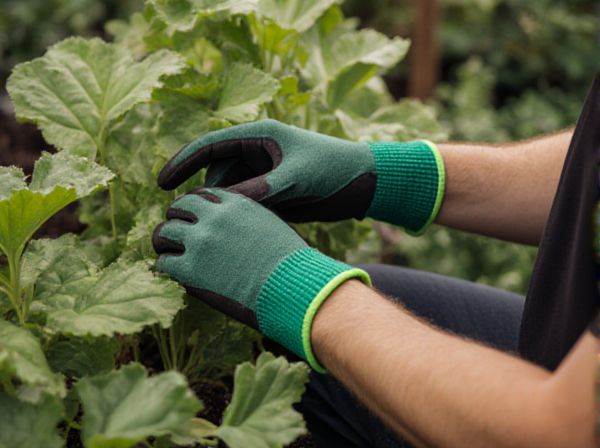
Handpicking vs Vacuuming Illustration
Handpicking pests allows for precise removal of individual insects, minimizing damage to plants and reducing pesticide use. Vacuuming offers a quicker, more efficient method to control large infestations by suctioning pests directly from foliage. Combining both techniques enhances integrated pest management by targeting pests at different stages and population levels.
Table of Comparison
| Method | Effectiveness | Speed | Cost | Environmental Impact | Best Use |
|---|---|---|---|---|---|
| Handpicking | High - direct removal of pests | Slow - labor intensive | Low - minimal equipment needed | Eco-friendly - no chemicals | Small-scale infestations, delicate plants |
| Vacuuming | Moderate to High - efficient for many pests | Fast - covers larger areas quickly | Medium - requires equipment investment | Eco-friendly - no chemicals, may disturb beneficial insects | Medium to large infestations, open areas |
Overview of Physical Pest Removal Methods
Handpicking and vacuuming are effective physical pest removal methods that target insects directly without chemicals. Handpicking is labor-intensive but precise, ideal for larger pests on small infestations, while vacuuming offers a faster, non-toxic approach that can reach hidden areas and collect multiple pests simultaneously. Both methods reduce pest populations sustainably and minimize environmental impact compared to chemical pesticides.
How Handpicking Works in the Garden
Handpicking involves manually removing pests like beetles, caterpillars, and aphids directly from plants, ensuring targeted control without harming beneficial insects. This method allows gardeners to carefully inspect leaves and stems, catching pests early to prevent infestations. Regular handpicking reduces pest populations effectively, minimizing the need for chemical treatments and supporting organic gardening practices.
The Science Behind Vacuuming Garden Pests
Vacuuming garden pests leverages suction power to effectively remove insects such as aphids, whiteflies, and spider mites from plant surfaces. This non-toxic method disrupts pest populations without harming plants, promoting a healthier garden ecosystem. Research shows that vacuuming minimizes pesticide use and reduces pest reproduction rates by physically eliminating pests at various life stages.
Pros and Cons of Handpicking Pests
Handpicking pests offers precise removal of insects like aphids and caterpillars, minimizing damage to plants without introducing chemicals, making it ideal for small infestations and organic gardening. However, it is labor-intensive, time-consuming, and less effective for large or widespread pest populations. This method also requires close monitoring and regular intervention to prevent re-infestation and ensure pest control success.
Advantages and Limitations of Vacuuming
Vacuuming effectively removes a wide range of pests such as aphids, spider mites, and whiteflies from plants without chemical use, promoting an eco-friendly pest control method. It allows for rapid removal across large areas, reducing pest populations quickly and minimizing potential plant damage. However, vacuuming may miss pests hidden in crevices or dense foliage and can sometimes cause physical harm to delicate plants or beneficial insects.
Comparing Efficiency: Handpicking vs Vacuuming
Handpicking pests offers precise removal, especially effective for small-scale infestations of larger insects like caterpillars or beetles, ensuring minimal damage to plants. Vacuuming covers a broader area rapidly, efficiently collecting numerous small pests like aphids and spider mites, making it ideal for moderate infestations. While handpicking provides targeted control, vacuuming improves efficiency by saving time and increasing pest removal volume in greenhouse and indoor garden settings.
Pest Types Best Suited for Each Method
Handpicking is most effective for larger, slow-moving pests such as caterpillars, beetles, and slugs, allowing precise removal without harming plants. Vacuuming excels with small, fast-moving insects like aphids, spider mites, and thrips, efficiently capturing infestations on leaves and stems. Selecting the appropriate method based on pest type enhances pest control efficiency and reduces the need for chemical treatments.
Impact on Beneficial Insects
Handpicking pests targets specific harmful insects while minimizing harm to beneficial insects like ladybugs and pollinators, preserving the ecosystem balance. Vacuuming removes both pests and beneficial insects indiscriminately, potentially disrupting natural pest control by reducing populations of beneficial predators. Careful handpicking supports sustainable pest management by maintaining beneficial insect biodiversity essential for healthy crop growth.
Environmental and Safety Considerations
Handpicking pests minimizes chemical exposure, reducing ecological impact and protecting beneficial insects, while vacuuming offers a non-toxic, mechanical method to remove pests efficiently without pesticides. Vacuuming can pose safety risks if the equipment is not handled properly, potentially causing allergens or pathogens to become airborne. Choosing between handpicking and vacuuming depends on the pest type, infestation level, and environmental sensitivity of the area.
Practical Tips for Successful Pest Removal
Handpicking pests like aphids or caterpillars from plants allows for precise removal and immediate pest reduction, especially effective in small gardens or on indoor plants. Vacuuming provides a faster solution for larger infestations by efficiently sucking pests off leaves and stems, ideal for pests like spider mites or whiteflies. For best results, combine handpicking with regular vacuuming, use equipment with adjustable suction to avoid plant damage, and perform these actions during cooler parts of the day to minimize stress on plants.
Handpicking vs Vacuuming Infographic

 gardendif.com
gardendif.com